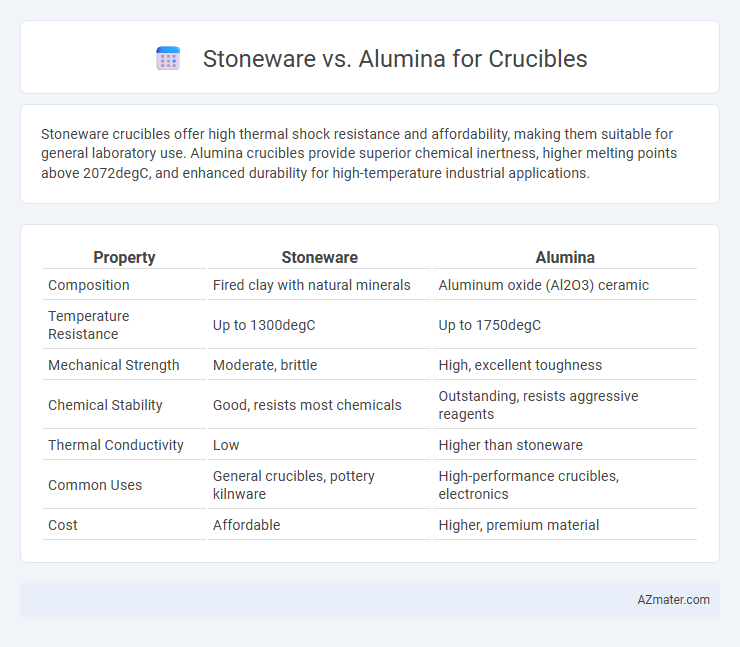Stoneware crucibles offer high thermal shock resistance and affordability, making them suitable for general laboratory use. Alumina crucibles provide superior chemical inertness, higher melting points above 2072degC, and enhanced durability for high-temperature industrial applications.
Table of Comparison
| Property | Stoneware | Alumina |
|---|---|---|
| Composition | Fired clay with natural minerals | Aluminum oxide (Al2O3) ceramic |
| Temperature Resistance | Up to 1300degC | Up to 1750degC |
| Mechanical Strength | Moderate, brittle | High, excellent toughness |
| Chemical Stability | Good, resists most chemicals | Outstanding, resists aggressive reagents |
| Thermal Conductivity | Low | Higher than stoneware |
| Common Uses | General crucibles, pottery kilnware | High-performance crucibles, electronics |
| Cost | Affordable | Higher, premium material |
Understanding Crucible Materials: Stoneware vs Alumina
Stoneware crucibles are made from dense, fired clay that offers good thermal shock resistance and affordability, making them suitable for lower temperature applications up to around 1200degC. Alumina crucibles, composed primarily of high-purity aluminum oxide, provide superior hardness, chemical resistance, and can withstand extremely high temperatures exceeding 1700degC, ideal for advanced metallurgical and laboratory processes. Selecting between stoneware and alumina depends on the specific thermal tolerance, chemical compatibility, and economic factors relevant to the intended crucible use.
Composition and Manufacturing Differences
Stoneware crucibles are primarily composed of natural clay, quartz, and feldspar, fired at high temperatures to achieve a dense, non-porous structure ideal for moderate temperature applications. Alumina crucibles consist mainly of high-purity aluminum oxide (Al2O3), produced through advanced ceramic processing techniques like sintering, which grants superior thermal stability and chemical resistance for extreme high-temperature environments. The manufacturing of stoneware involves traditional shaping and kiln firing, whereas alumina crucibles require precise powder processing and high-temperature sintering to ensure enhanced mechanical strength and longevity.
Thermal Stability and Heat Resistance
Stoneware crucibles exhibit excellent thermal stability with the ability to withstand gradual temperature changes up to around 1200degC, making them suitable for moderate heat applications. Alumina crucibles offer superior heat resistance and thermal stability, tolerating temperatures exceeding 1700degC and rapid thermal cycling without cracking. The higher melting point and thermal conductivity of alumina provide enhanced durability in high-temperature laboratory processes compared to stoneware.
Chemical Compatibility and Corrosion Resistance
Stoneware crucibles exhibit high chemical compatibility with non-reactive substances and offer moderate corrosion resistance, making them suitable for general laboratory use with acids and salts. Alumina crucibles demonstrate superior chemical inertness and exceptional corrosion resistance, especially against harsh oxidizing and reducing environments, ensuring longevity in high-temperature applications. The choice between stoneware and alumina depends on the specific chemical conditions and durability requirements of the process.
Mechanical Strength and Durability
Stoneware crucibles offer moderate mechanical strength and good resistance to thermal shock, making them suitable for general laboratory use. Alumina crucibles exhibit superior mechanical strength and exceptional durability due to their high purity and dense microstructure, enabling them to withstand higher temperatures and aggressive chemical environments. The enhanced hardness and abrasion resistance of alumina significantly extend the lifespan of crucibles in industrial and high-temperature applications.
Cost Comparison and Availability
Stoneware crucibles generally offer a lower cost solution compared to alumina crucibles, making them suitable for budget-sensitive applications. Alumina crucibles, while more expensive, provide superior thermal resistance and chemical inertness, often justifying the higher price in high-temperature or corrosive environments. Availability of stoneware crucibles tends to be wider due to their common use in educational and basic laboratory settings, whereas alumina crucibles are primarily supplied by specialized manufacturers catering to advanced industrial and research demands.
Suitable Applications for Stoneware Crucibles
Stoneware crucibles are ideal for low to medium-temperature applications such as melting metals like silver, gold, and lead, as well as for holding chemicals in laboratory settings due to their excellent resistance to thermal shock and chemical corrosion. Their porous structure allows for gradual temperature changes, making them suitable for heat treatment processes and ceramic glaze testing. Compared to alumina crucibles, stoneware offers cost-effective durability for non-extreme thermal environments, ensuring reliable performance in educational labs and artisanal metalworking.
Typical Uses of Alumina Crucibles
Alumina crucibles are widely used in high-temperature laboratory applications due to their excellent thermal stability, chemical resistance, and mechanical strength. They are ideal for melting metals, glass, and ceramics, as well as conducting high-purity sample preparation and chemical analysis. Alumina crucibles outperform stoneware in environments requiring resistance to thermal shock and corrosive materials.
Cleaning, Care, and Lifespan Considerations
Stoneware crucibles offer ease of cleaning due to their smooth, non-porous surface, making residue removal straightforward after each use, while alumina crucibles require careful handling with specialized brushes to prevent scratches that can trap contaminants. Alumina's superior thermal and chemical resistance extends its lifespan significantly, but its care involves avoiding rapid temperature changes that can cause cracking, whereas stoneware is more prone to wear but tolerates gradual thermal shifts better. Proper maintenance of both materials involves routine inspection for cracks or chips to ensure longevity and consistent performance in high-temperature applications.
Choosing the Right Crucible for Your Needs
Stoneware crucibles offer excellent thermal shock resistance and are ideal for general-purpose applications requiring moderate temperatures up to 1300degC. Alumina crucibles provide superior chemical resistance and higher melting points exceeding 1700degC, making them suitable for high-purity and high-temperature processes. Selecting the right crucible depends on the specific temperature range, chemical compatibility, and durability requirements of your application.

Infographic: Stoneware vs Alumina for Crucible
 azmater.com
azmater.com